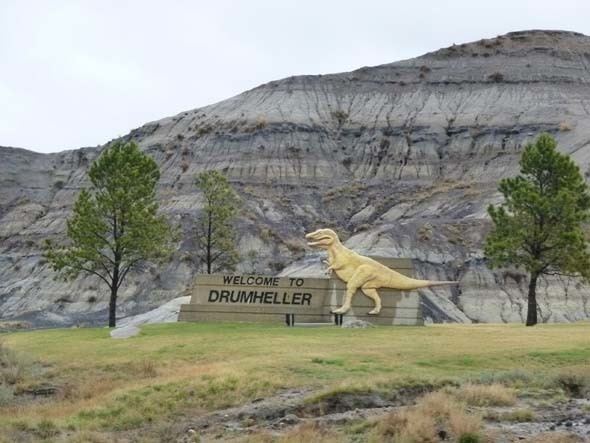Country Canada Founded 1912 Population 7,982 (2016) | Province Alberta Census division 5 Amalgamated January 1, 1998 Local time Tuesday 12:39 AM | |
 | ||
Weather -16°C, Wind N at 6 km/h, 82% Humidity Points of interest Royal Tyrrell Museum, World's Largest Dinosaur, Atlas Coal Mine, Star Mine Suspension Bridge, Midland Provincial Park | ||
How to visit drumheller alberta canada travel video tourism guide
Drumheller /drʌmˈhɛlər/ is a town (formerly a city) within the Red Deer River valley in the badlands of east-central Alberta, Canada. It is located 110 kilometres (68 mi) northeast of Calgary. The Drumheller portion of the Red Deer River valley, often referred to as Dinosaur Valley, has an approximate width of 2 kilometres (1.2 mi) and an approximate length of 28 kilometres (17 mi).
Contents
- How to visit drumheller alberta canada travel video tourism guide
- Map of Drumheller AB Canada
- The alberta story hunting dinosaurs in drumheller
- History
- Demographics
- Climate
- Attractions
- Royal Tyrrell Museum
- Notable people
- Newspapers
- Radio
- Television
- References
Map of Drumheller, AB, Canada
The alberta story hunting dinosaurs in drumheller
History
The town is named for Colonel Samuel Drumheller, who bought land in 1910 and started coal mining operations there in 1911. Drumheller became a railway station in 1912. It then incorporated as a village on May 15, 1913, a town on March 2, 1916 and a city on April 3, 1930. Over a 15-year period, Drumheller's population increased 7002857000000000000♠857% from 312 in 1916 to 2,987 in 1931 shortly after becoming a city.
The City of Drumheller amalgamated with the Municipal District (MD) of Badlands No. 7 on January 1, 1998 to form the current Town of Drumheller. Some of the reasons the two municipalities amalgamated included the MD of Badlands No. 7 having more in common with Drumheller than other surrounding rural municipalities and both were experiencing similar planning and development issues due to their locations within the Red Deer River valley. The amalgamated municipality opted for town status rather than city status so that highways within would remain the responsibility of the Province of Alberta. As a result of the amalgamation, Drumheller became Alberta’s largest town in terms of land area at 107.93 square kilometres (41.67 sq mi).
The 1998 amalgamation resulted in Drumheller absorbing six hamlets that were previously under the jurisdiction of the MD of Badlands No. 7 – Cambria, East Coulee, Lehigh, Nacmine, Rosedale and Wayne. Drumheller also previously absorbed the hamlets of Bankview, Midlandvale (Midland), Newcastle and North Drumheller during annexations while under city status. Bankview and Midland were annexed in 1964 and 1972 respectively, while Newcastle and North Drumheller were both annexed in 1967. Other localities within Drumheller, either absorbed through past annexations or its eventual amalgamation with the MD of Badlands No. 7, include Aerial, Eladesor, Kneehill, Rosedale Station, Western Monarch (Atlas) and Willow Creek.
In total, Drumheller has absorbed at least 13 other communities in its history, some of which are now recognized as neighbourhoods or districts within the town.
Drumheller has been the filming location for more than 50 commercials, television and cinematic productions including Running Brave, MythQuest, Unforgiven, ABC's miniseries Dreamkeeper and TNT's miniseries Into the West.
Demographics
In the 2016 Census of Population conducted by Statistics Canada, the Town of Drumheller recorded a population of 7,982 living in 3,164 of its 3,471 total private dwellings, a 3000400000000000000♠−0.6% change from its 2011 population of 8,029. With a land area of 108.03 km2 (41.71 sq mi), it had a population density of 73.9/km2 (191.4/sq mi) in 2016.
In the 2011 Census, the Town of Drumheller had a population of 8,029 living in 3,182 of its 3,418 total dwellings, a 1.2% change from its 2006 population of 7,932. With a land area of 107.93 km2 (41.67 sq mi), it had a population density of 74.4/km2 (192.7/sq mi) in 2011.
Climate
Drumheller experiences a Semi-arid climate (BSk). The highest temperature ever recorded in Drumheller was 40.6 °C (105 °F) on 18 July 1941. The coldest temperature ever recorded was −43.9 °C (−47 °F) on 29 January 1996.
Attractions
South of the traffic bridge over the Red Deer river on Highway 9 is the World's Largest Dinosaur, a 26.2-metre (86 ft) high fiberglass Tyrannosaurus rex that can be entered for a view of the Badlands, including the adjacent 23 metre (75 ft) water fountain, again one of the largest in Canada. Tourist attractions also include the Star Mine Suspension Bridge, Atlas Coal Mine, Canadian Badlands Passion Play, Horseshoe Canyon, Water Spray Park, Aquaplex with indoor and outdoor pools, Horse Thief Canyon, hoodoos, Midland Provincial Park, the Rosedeer Hotel in Wayne, 27 kilometres (17 mi) of constructed pathways, Bleriot Ferry, East Coulee School Museum, Homestead Museum, Valley Doll Museum and the Little Church which is capable of seating only six patrons.
Next to Drumheller ski hill is the Canadian Badlands Passion Play site, where, for two weeks each July, performances are held. Companies are composed of actors from all over Alberta. The site also offers small plays throughout the summer and an interpretive centre.
Royal Tyrrell Museum
The Royal Tyrrell Museum of Palaeontology is a museum that hosts Canada's largest collection of dinosaur fossils. It boasts 375,000 visitors a year, the largest of all provincial museum attractions. It opened on September 25, 1985. The Royal Tyrrell Museum is located in the northwest quadrant of the Town of Drumheller, in Midland Provincial Park.
Notable people
Newspapers
Newspapers covering Drumheller include the weekly Drumheller Mail, which has been publishing every Wednesday since 1911 and has been owned by the Sheddy family since 1954.
Radio
Television
All stations are analogue relays of stations from Calgary.
